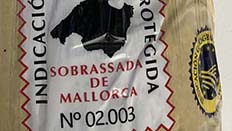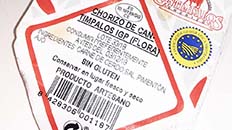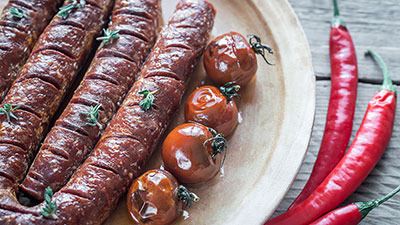Meats and Sausages
Spanish Sausages Overview
In prehistoric times, about 3000 B.C., meat was already preserved in Egypt with salt. The procedure was simple: the meat was sliced thin, salted, and dried in air. With time we learned the benefit of smoking, thinking it preserved the meat, although it was the drying that accomplished the task. The smoke played an important part in the process by inhibiting the growth of bacteria, keeping insects at bay, and providing a well-liked flavor.
The oldest ever reference to a sausage mentioned in written literature comes from Homer’s Odyssey written in the ninth century B.C., book XX, verse 25:
“And as a man with a paunch pudding, that has been filled with blood and fat, tosses it back and forth over a blazing fire, and the pudding itself strains hard to be cooked quickly; so he was twisting and turning back and forth, meditating how, though he was alone against many, he could lay hands on the shameless suitors.”
The above is the first written record of the grilled sausage. In the first century A.C., Italian author Marcus Gavius Apicius mentions“botellus” (small sausage) in his famous work “De re coquinaria” (On the Subject of Cooking) which many sources link to Spanish botelo or botillo del Bierzo. Other sources give credit to Spanish monks from Monasterio de Carracedo as they mention “botellus” in their writings in the Middle Ages.
Of most significance was an anonymous cookbook written in XIII century Andalusia just before King Don Fernando III liberated Spain from Morrocan Arabs who dominated the Iberian Peninsula from 1147 to 1269. The book was called Spanish-Arabic Cuisine (La cocina hispano-magrebí) and included an entire part dedicated to meat recipes: sausages, meat balls, liver spreads, ground meats, and usage of spices. In 1324 appeared, The Book of Sent Sovi (Libro de Sent Soví); the oldest surviving culinary text in Catalan. This very practical book contained sections about seafood, poultry and wild game, among other topics. XV century is the point when home sausage making takes off on a grand scale. Cows are grown for milk and meat, but they feed on pasture out of sight. They are slaughtered in slaughter houses and commercially distributed.
Pigs, however, feel comfortable and safe with humans so they are close by. Even during wars when inhabitants of villages ran away to hide in a forest, the pigs did the same, where they were able to feed themselves. When the situation normalized, the pigs would return to the village.
In the winter time, usually around Christmas, a pig would be slaughtered during a local celebration known as “la matanza” (the slaughter). It was a social event where families and neighbors participated together, sharing duties, tasks, and knowledge. This fiesta would go for a few days where a whole pig was transformed into a variety of products following simple sanitary rules. Parts that spoil first like blood and offal meat (liver, heart, kidney, spleen, lungs, cleaned entrails) would be processed on the first day into blood and liver sausages. Other meat trimmings and fat would be made into sausages. Noble parts such as hams, loins, and pork belly would be salted and preserved for later.
Christopher Columbus’ discovery of America in 1492 opened the door to a myriad of foods previously unknown in Spain: peppers, potatoes, and new spices like allspice from Jamaica. The most important for sausage production was pepper, which grew quite well on Spanish soil and, in time became the “pimentón”, which is an absolute must-have ingredient for chorizos, sobrasadas, and other Spanish sausages, giving them characteristic color and flavor. Sausages became popular not only with villagers but with royalty as well:
King Carlos IV, nicknamed “the hunter” due to his love for the sport, displayed a great affinity for sausages which has been immortalized in the following story: on one of his hunting trips in the mountains of Salamanca province, the king became hungry and discovered that his bag did not contain any provisions. Then by a stroke of luck in the village of Candelario, he encountered a peasant named Uncle Rico (Tio Rico) who was carrying a variety of sausages to deliver them to town. The king found them delicious and started to devour them one by one. With his hunger gone and being in a good mood the king granted the peasant permission to be the official supplier of sausages to the palace. The story is depicted in a famous painting by Ramón Bayeu “Choricero de Candelario” (sausage maker from Candelario) which is displayed in Prado Museum in Madrid.
Spanish king Alfonso XII (1874-1885) was so fond of Salchichón de Vic that he always had this sausage in his kitchen.
Geographical Location and Climate Conditions
The traditional sausage-making process was greatly influenced by the location of the manufacturing facility. Latitude and elevation control temperature. Proximity to the sea, rivers, and lakes affects humidity. Mountains have an influence on temperature and wind, and the time of the year affects the conservation of the product. All those factors played a crucial part in home production. Today, we can control parameters such as temperature, humidity, airspeed, or smoke temperature in computer-controlled chambers, but in the past, we had to work with mother nature together. Even so, the above-mentioned equipment due to its cost, is used by commercial producers and not by a typical hobbyist.
Spain is not a huge country, about 500 km in length and 1000 km at its widest point. With Portugal on the left, most of Spain is also about 500 km wide. Eastern Spain faces the Mediterranean Sea, the north-western Atlantic Bay of Biscay, and northern Spain shares the Pyrenees Mountains with France. There are not many lakes or rivers. Overall the country is blessed with proper conditions for drying due to mild temperatures and constant prevailing winds. In northern parts, temperatures can drop very low, but that is corrected by warming the drying chambers with slow-burning wood. Another solution was hanging sausages above a wood-fired kitchen stove or moving them to a different area.
Spanish Regions
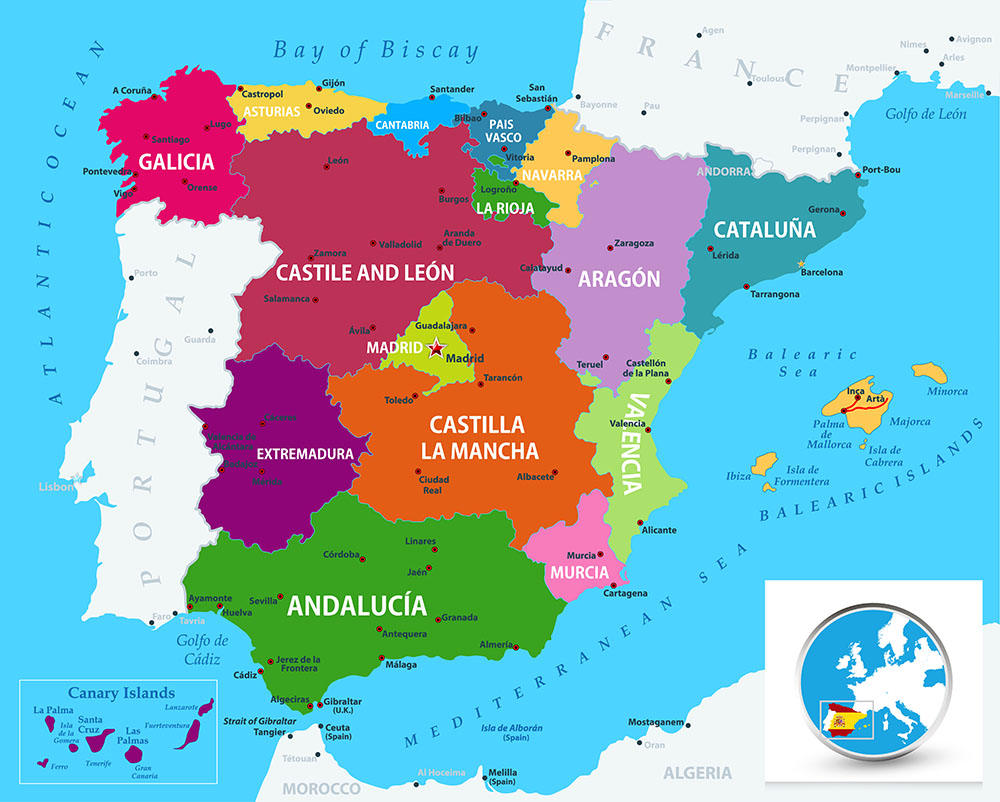
Spanish Regions
There are 17 autonomous regions in Spain and each one produces meats and sausages: Andalusia, Aragon, Asturias, Balearic Islands, Basque Country, Canary Islands, Cantabria, Castile-La Mancha, Castile-Leon, Catalonia, Extremadura, Galicia, La Rioja, Madrid, Region de Murcia, Navarre and Region de Valencia.
Taking under consideration the physical location where sausages are made, we can generalize sausages into two groups:
- Sausages made in the eastern region of Iberian Peninsula, basically the Spanish Mediterranean coast. Starting from top: the northern Catalonia (Barcelona, Girona), Valencia (Alicante, Castellon, Valencia), southern Aragon (Teruel), Murcia (Cartagena, Murcia), the eastern part of Castile-La Mancha (Albacete and Cuenca), eastern Andalusia (Almería, Granada and Jaén), and Balearic Islands (Majorca, Minorca, Ibiza). A little use of pimentón and preference for cooked sausages are the factors that distinguish this area, also known as “Levante,” from other regions in Spain. In this area pimentón is seldom added, except for the Balearic Islands whose famous “sobrasada” always includes a hefty dose of it. There are not known chorizos that originate from the Levante area of Spain. Catalonia is known not only for its cooked butifarras, but for some of the greatest dry sausages as well: Salchichón de Vic, fuet, and secallona.
- Sausages made in other regions: Extremadura, Castilla La Mancha, Castile-León, Community of Madrid, Galicia, Asturias, Cantabria, País Vasco, La Rioja, Navarra, and Arragón are made with or without pimentón and are usually uncooked.
Morcillas (blood sausages) are cooked and made everywhere. There is a small number of dry morcillas: Asturiana, Serrana, de Badajoz, de corizoCalabaza, de Despojos. This breaks the cooking rule and makes them quite unique.
Naming Spanish Sausages
Anybody hearing the name salami can visualize this type of sausage and most people hearing the word chorizo know it is a Spanish sausage. However, the world of sausages becomes confusing when we see descriptions such as embutido, salchichόn, salchicha, longaniza, longanissa, morcilla, morcilla negra, morcilla blanca, botelo, butelo, butifarra, botifarra, botagueña, morcόn, chorizo blanco, sobrasada, lomo embuchado and others.
The sausage name usually starts with the sausage type and is followed by the name of the region where the product was made. Examples of morcilla:
- Morcilla Asturiana – denotes a blood sausage from Asturias.
- Morcilla Extremeńa – blood sausage from Extremadura.
- Morcilla Toledana – blood sausage from Toledo (Toledo is the city in the province of Toledo, Castile - La Mancha region.
- Morcilla Gallega – blood sausage from Galicia.
- Morcilla Riojana – blood sausage from La Rioja.
- Morcilla Riojana de Arroz - blood sausage with rice from La Rioja.
- Morcilla Dulce Riojana - sweet blood sausage from La Rioja.
- Morcilla Dulce Canaria - sweet blood sausage from Canary Islands.
- Morcilla de Cebolla de León - blood sausage with onions from León.
- Morcilla de Cebolla Valenciana - blood sausage with onions from Valencia.
Spanish sausage names on our website have been left in the original, but the English equivalent follows in parenthesis or in text. This way it will be easy to get more information about a particular sausage on the Internet, if one so desires. Most known sausages are not translated into English: Bratwurst, Bockwurst, Liverwurst, Salami, Salami Milano, Pepperoni, and Mortadella, sausages are completely different from each other, yet the consumer understands what product he is getting. It is best to leave Spanish names alone, all that is needed is to get familiar with 6-8 major groups (morcilla, chorizo, longaniza, salchichón, butifarra etc), after all they are already known in Spanish speaking countries. Renaming them will only create confusion.
Application of Smoke in Spanish Sausages
Let’s quote the 1967 edition of The Spanish Meat Encyclopedia:
“Neither our industry nor our market prepares or accepts smoked products, however, in some areas there are available small quantities of smoked herrings packed in drums.”
“Our butchers (la chacineria) quite often smoke meats: however, in no case the application of smoke is considered to be a unique and characteristic technique of meat preservation, for our butchers, the smoke is just a factor, not particularly important one, that is incorporated in process of curing sausages. Smoked meats, smoked fish, totally smoked, are not prepared in Spanish food industry, smoked delicacies are products of northern countries.”
The application of smoke was reserved for heating the drying chamber in winter months when temperatures were dropping low. The chambers were heated by slow burning wood and that produced cold smoke during part of the process.
Indication of Quality
Traditionally made sausages were made from leaner meats than commercially produced products of today. In addition, mass produced sausages contain ingredients such as starches, antioxidants, nitrates, curing accelerators, colorants, protein concentrates, color stabilizers, sugars, hydrocolloids (gums), powdered milk, phosphates and more. All those ingredients decrease production time, lower costs and extend the shelf life of the products to give supermarkets sufficient time for selling them. To buy the best quality sausage read the label. A good indication of quality is the casing - is it natural or synthetic. All sausages carrying European Certificates of Origin are stuffed in natural casings and do not contain chemicals.
Spanish Sausages Carrying European Protection Certificate
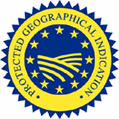
PGI - Protected Geographical Indication (PGI) - the geographical link must occur in at least one of the stages of production, processing or preparation.
- Chorizo de Cantipalos, PGI 2011
- Chroizo Riojano, PGI 2010
- Salchichón de Vic; Longanissa de Vic, PGI 2001
- Sobrasada de Mallorca, PGI 1996
- Botilo del Bierzo, PGI 10/10/2001
- Chosco de Tineo, PGI 2011
- Morcilla de Burgos, PGI 2018
Spanish Sausages Today
Unfortunately, artisan sausage making in Spain follows the same trend as in other countries; young people move to large cities and are less inclined to maintain family traditions which include general cooking skills and making sausages. However, people living in rural areas still gather together to celebrate the “la matanza” ritual the same way it has always been done. In addition, in areas recognized for the superb sausages, there are numerous shows and festivities, for example “chireta festival” in Aragon or “la festa de androlla” in Galicia. Spain is famous for a number of original sausages: chorizo, longaniza, sobrasada, lomo embuchado, salchichón, fuet, morcilla, androlla, botelo or buche de costillas and others.
Cooked sausages like salchichas or liver sausages are made in other European countries and although they carry different names, they differ little from Spanish ones as they are made with the same technology, from similar meats and spice combinations. It is only fair to give special recognition to morcilla as there is no other country with such a variety of blood sausages as Spain.
Dry fermented sausages account for about 15% of all meat products produced in Spain. Pork is the most common meat, although beef and lamb are also occasionally used. A wide variety of raw-fermented and dried sausages are produced, and the methods of production, choice of materials, and spices have been strongly influenced by geographical location and climate conditions. Today, with the advance of technology, the importance of climate and location plays a lesser role, at least for commercial producers, as parameters such as temperature, humidity and airflow are computer-controlled.
Home production still relies on traditional methods, however, even hobbyists today use nitrite curing salts and starter cultures. What separates Spanish sausages from others is meat selection, heavy usage of locally grown paprika (pimentόn), and marinating meats with spices (adobo).
Following the same trend that is happening in other countries little butcher shops are pushed out of existence, at least in large metropolitan areas, by huge supermarkets that carry a variety of foods on one floor. They do not manufacture their own cheeses, hams, or sausages, but buy them at wholesale prices from the manufacturers. It is impossible for a small store to compete with giants like El Corte Inglés or Museo de Jamón, the last one not being a museum but a combination of a huge meat store and a restaurant. A customer can buy a sample of ham, loin, or one of many sausages and enjoy it with wine or beer. After teaming with life markets like Mercado de la Cebada, established in 1875, there are only a few remaining butcher and fish stores that carry a wide assortment of quality products, but a few customers are walking around.
Out in the country small butchers face less competition from large industry giants for whom starting a big supermarket may not be the best investment. Butchers in large cities who have a chance of continuing business are those who own their stores and have a local trusted clientele.
South American-Latin American-Caribbean and Filipino Sausages
All these countries owe much of their culture to Mother Spain, and culinary arts are not an exception. Not surprisingly, all Spanish sausages are popular there although different climatic conditions have a profound influence on the methods of their manufacture. Most sausages made in Spain were air dried as the country was blessed with dry prevailing winds for most of the year, but in other Spanish-speaking countries, the climate is hot and humid so choosing air drying as the main processing method would be severely limited. An exception would be Argentina and Chile which are large countries with many climatic zones. Making dry sausages in Latin American countries or hot and humid tropical islands of the Caribbean Basin offers many challenges unless drying takes place in controlled chambers. All those countries add vinegar (sometimes wine) as these acidic fluids help to preserve food at least to a certain degree.
Many countries (Cuba, Dominican Republic, Philippines) always faced energy problems and a large percentage of the population did not own refrigerators. A very common method was to keep sausages in barrels filled with lard. Dominican longanizas included orange juice and were usually dried in the sun. Locals often come up with ingenious solutions, for example, Nham, an uncooked, fermented semi-dry Thai sausage very popular in Asia. It is made from fresh lean pork, pork skins, cooked rice, fresh garlic, eye bird chilies and is wrapped in banana leaves. Garlic is added at 5% (50 g/1 kg material) and this large amount inhibits the growth of undesired bacteria. Nevertheless, any kind of sausage can be successfully produced if we can apply and maintain the right temperatures and humidity.

